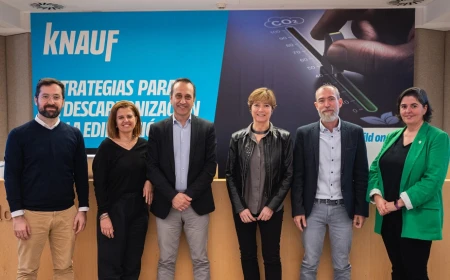
Among other conclusions, a global reduction of up to 133 kg of CO2 was observed per square meter built, representing an improvement of up to 18% of the building using Knauf solutions compared to the CTE-compliant reference building, taking into account the standard air conditioning system usual in the market. In absolute terms, there is a reduction of 1,750 tons of CO2, distributed between homes, representing 24 tons of CO2 saved per home; Turning Knauf solutions into a carbon removal tool.
The Spain 2022 Environmental Profile reveals several important indicators, with a particular focus on those affected by construction practices. These include final household energy consumption, greenhouse gas emissions by sector, the consumption footprint which assesses the environmental impacts of consumption, and the circularity ratio which measures the efficiency in the use of recovered materials compared to total demand.
These indicators provide a comprehensive view of how construction and consumption decisions affect the environment in Spain. Thus, according to data from the Ministry of Environmental Transition and Demographic Challenge, the household sector consumed about 15 thousand kilotons (tons of oil equivalent) during 2021, that is, 18.8% of the total final energy consumption in our country. Therefore, it is important to measure the impact of the building systems used in Spain. Thus, in this building of 73 houses in Madrid, Knauf proposes some of the most advanced construction solutions, such as the external enclosures of the Aquapanel system, the Shaftwall system in the elevator shaft structure or the Knauf Lightboard roof.
The study showed a reduction of up to 95 kg of CO2 per square meter built, representing an 18% improvement in a Knauf building compared to a conventional building, over its life cycle.
Reducing the impact on the manufacturing stage
The greatest improvement in terms of incorporated carbon is achieved during the manufacturing phase, where significant percentages of reduction are observed per square meter of building solution. Particularly notable are the internal partitions (63%), which not only represent an improvement in terms of integrated carbon, but also improve the useful surface, since they have a lower thickness compared to conventional solutions.
In terms of operational carbon, a reduction of up to 37 kg of CO2 per square meter was observed, representing a 17% improvement in the Knauf building compared to a conventional building. In terms of final energy and cost, this could mean a saving of €5,640 per home over the 60-year period studied.
View study and analysis with experts
The study was presented within the framework of the conference “Strategies for Decarbonization of Buildings: Proposals from the Front Lines” held by the Green Building Council of Spain (GBCe) with Knauf at the Castellar Building in Madrid. During the conference, attendees were able to learn about the latest developments in the European regulatory framework (EPBD, GPP, classification…) from Alphonse Ventura, technician from the GBCE Development and Content area. Afterwards, an interesting table discussion was held moderated by Dolores Huerta, Director General of GBCE, in which experts such as Anna Guanter, Head of Innovation at Promotora Culmia participated; Christina Sendra, Technical Director for Eco-Smart Growth; Miguel Díaz, partner architect of Ruiz Larrea studio and technical staff of Alfons Ventura at GBCe.
Dolores Huerta, Director General of GBCE: “The goal of the current regulatory framework is to revolutionize our regulation, moving from voluntary to mandatory conditions. This environmental revolution aims to put Europe at the forefront of competitiveness in a future in which resources become more scarce and in an environmental crisis to which we must adapt. We must be prepared, and what better way to do that than by coming together to help each other.
Pablo Maroto, Marketing and Technical Director at Knauf Iberia “With this study we wanted to be ambitious by focusing, among other aspects, on the circular economy of the industry. The barriers it faces are multiple and the infrastructure surrounding it is complex, but we must work to create synergies through which its implementation in In this sense, we at Knauf are constantly reviewing our products and solutions to reduce their embedded carbon footprint, in order to provide the maximum possible value to our customers and the industry alike.
Miguel Díaz, partner architect of Ruiz Larrea Studio, It states “Design is one of the fundamental pieces when we talk about constructing buildings. Part of our work consists of performing a life cycle analysis of buildings to be able to build in the best possible way, but currently there is no homogeneous methodology for doing this. Therefore, we need to constantly measure and learn, without stopping “Demanding this commitment in our jobs is a huge challenge, but we have to understand our ultimate goal and we will overcome it together.”
Cristina Sendra, Technical Director for Eco-Smart Growth, pointing to: “We are in the initial stages of integrating sustainability into the sector, where not everything is developed yet. On the one hand, we are promoters of change, and on the other hand, we have a responsibility to influence this standardization of the measurement model. So the solution is for us all to come together to be able to Working together, between competitors and organizations “This way we can speak the same language, pool the most specialized knowledge and share it with the world.”
Anna Guenter, Head of Innovation at Promotora Culmia, It states: “A torrent of information and processes is coming from Europe, and we don't see how to integrate all this into our operations. We need time to absorb the challenge of decarbonizing construction, and support change, not only in citizens, but in the business culture as well.
Alphonse Ventura, GBCE Development and Content Area Technician: “The Levels Framework is called upon to be the reference for future building systems across Europe. Our work in this sense is to accompany the group of sub-sectors in this transition towards change, and to show that all of this is workable, regardless of the difficulties it may encounter.
If you want more information about Knauf:
www.knauf.es

“Beeraholic. Friend of animals everywhere. Evil web scholar. Zombie maven.”

